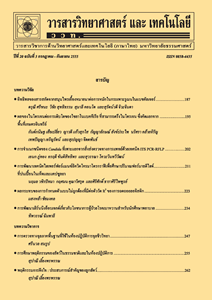การเชื่อมประสานของแอกโตไมโอซินธรรมชาติโดยการเติมสารสกัดจากใบพืช
Main Article Content
Abstract
บทคัดย่อ
วัตถุประสงค์ของงานวิจัยนี้เพื่อศึกษาปริมาณสารประกอบฟีนอลิกทั้งหมด และปริมาณแทนนินของสารสกัดจากใบพืช 10 ชนิด ได้แก่ กุยช่าย (Allium tuberosum Rottl. ex Spreng) บรอกโคลี (Brassica oleracea L. var. italica) บัวบก [Centella asiatica (L.) Urban] ตำลึง [Coccinia grandis (L.) Voigt] ชะมวง (Garcinia cowa Roxb. ex DC.) ยอ (Morinda citrifolia L.) โหระพา (Ocimum basilicum L.) กะเพราแดง (Ocimum tenuiflorum L.) ผักแพว [Persicaria odorata (Lour.) Soják] และย่านาง [Tiliacora triandra (Colebr.) Diels] และนำสารสกัดจากใบพืชที่มีปริมาณแทนนินมากที่สุดไปศึกษาการเชื่อมประสานของแอกโตไมโอซินธรรมชาติ พบว่ามีปริมาณสารประกอบฟีนอลิกทั้งหมดและปริมาณแทนนิน 26.29-197.86 และ 10.03-171.77 มิลลิกรัม gallic acid/กรัมตัวอย่างแห้ง ตามลำดับ โดยผักแพวมีปริมาณของสารประกอบฟีนอลิกและแทนนินสูงที่สุดเท่ากับ 197.86 และ 171.77 มิลลิกรัม gallic acid/กรัมตัวอย่างแห้ง ตามลำดับ และพบว่าสารสกัดจากพืชที่ผ่านการออกซิไดซ์มีปริมาณของสารประกอบฟีนอลิกและปริมาณแทนนินลดลงอย่างมีนัยสำคัญ (p≤0.05) เมื่อเปรียบเทียบกับสารสกัดจากพืชที่ไม่ผ่านการออกซิไดซ์ เมื่อเติมสารสกัดจากใบพืช 4 ชนิด ที่ผ่านการออกซิไดซ์แล้ว มีปริมาณแทนนินสูงที่สุด ได้แก่ ผักแพว กะเพราแดง บัวบก และชะมวง ร้อยละ 0-10 ของปริมาณโปรตีน ลงในแอกโตไมโอซินธรรมชาติ (natural actomyosin, NAM) ที่สกัดจากซูริมิปลาฤาษี (Mulloidichthys martinicus) พบว่าการเติมสารสกัดในปริมาณที่เพิ่มขึ้น ทำให้ NAM มีปริมาณของหมู่ sulphydryl ทั้งหมด และค่า surface hydrophobicity ที่ลดลง (p≤0.05) การศึกษาองค์ประกอบหน่วยย่อยของโปรตีนโดย SDS-PAGE พบว่าแถบไมโอซินสายหนักมีความเข้มลดลง และพบแถบของโปรตีนที่เกิดการรวมตัวกันมากขึ้น การเติมสารสกัดจากผักแพวที่ถูกออกซิไดซ์ลงใน NAM จากซูริมิปลาฤาษีมีประสิทธิภาพในการเชื่อมประสานโปรตีนเส้นใยกล้ามเนื้อในระดับความเข้มข้นที่น้อยกว่าการเติมสารสกัดจากกะเพราแดง
คำสำคัญ : สารประกอบฟีนอลิก; แทนนิน; การเชื่อมประสาน; แอกโตไมโอซินธรรมชาติ; ปริมาณหมู่ซัลฟไฮดริลทั้งหมด; ค่าไฮโดรโฟบิกพื้นผิว
Abstract
The objectives of this study was to analyzed total phenolic and tannin content of 10 plants leaf extract, that were Chinese chives (Allium tuberosum Rottl. ex Spreng), Broccoli (Brassica oleracea L. var. italica), Asiatic pennywort [Centella asiatica (L.) Urban], Ivy gourd (Coccinia grandis (L.) Voigt), Cowa (Garcinia cowa Roxb. ex DC.), Noni (Morinda citrifolia L.), Thai basil (Ocimum basilicum L.), Holy basil (Ocimum tenuiflorum L.), Vietnamese coriander [Persicaria odorata (Lour.) Soják] and Yanang [Tiliacora triandra (Colebr.) Diels]. Then, cross-linking of natural actomyosin by addition of plants leaf extract with the highest tannin content was investigated. The result was expressed that the total phenolic and tannin content ranged from 26.29-197.86 mg gallic acid/g dry sample and 10.03-171.77 mg gallic acid/g dry sample, respectively. The highest total phenolic and tannin content were found in Vietnamese coriander, those were 197.86 and 171.77 mg gallic acid/g dry sample, respectively. In addition, the decrease in total phenolic and tannin content were observed in the oxidized plants extract when compared with the sample without oxidation (p≤0.05). Four plants leaf extract with the highest tannin content; Vietnamese coriander, Holy basil, Asiatic pennywort and Cowa were added at 0-10 % by protein content; into natural actomyosin (NAM) from goatfish (Mulloidichthys martinicus) surimi. It was found that the decrease in total sulphydryl group content and surface hydrophobicity (p≤0.05) were occurred with the higher concentration of the extract. Investigation of protein subunit by SDS-PAGE revealed that the intensity of myosin heavy chain (MHC) band was decreased accompanying with the polymerized protein band. Moreover, the addition of oxidized Vietnamese coriander leaf extract into NAM from goatfish surimi could increase a cross-linking of myofibrillar protein effectively with the lower concentration than that of the extract from Holy basil.
Keywords: phenolic compound; tannin; cross-linking; natural actomyosin; total sulphydryl groups; surface hydrophobicity

